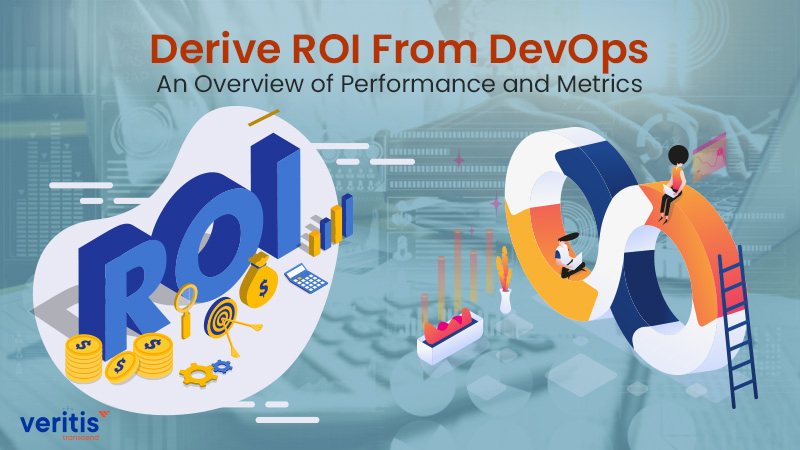
DevOps brought about a significant change in the software delivery process. It has increased the pace of software delivery and facilitated a new form of collaboration among the teams involved.
This, in turn, resulted in a flexible environment, causing an overall cultural transformation within the organizational functioning. All these are directly reflected in enhanced performance, improved productivity, reduced time-to-market, cost savings, lower failure rate, and faster recovery.
Because of these benefits, DevOp’s popularity has been growing by leaps and bounds and continuing at a skyrocketing pace. What drove this DevOps demand? Organizations say it’s the Return on Investment (ROI) on DevOps investment!
What is ROI From DevOps and How to Measure it
A company’s success hinges on the velocity of its software development efforts. Many IT companies have adapted and evolved in response to technological trends, embracing advanced software delivery practices.
DevOps has exceeded expectations and brought significant advantages to organizational business functions. Organizations increasingly favor DevOps benefits for business due to its holistic and intuitive work culture. When considering the adoption of DevOps for your company, it’s crucial to understand that it encompasses a series of interconnected processes, encompassing software development, testing, deployment, and related tasks, executed promptly, reliably, and consistently.
DevOps has expedited the software delivery pipeline and contributed to an improved customer experience, timely failure detection, cost savings, swift recovery, and more.
Beyond the benefits, organizations must address a notable concern as they embark on their DevOps transformation journey: how to quantify the Return on Investment (ROI) of DevOps? Let’s delve into the following sections for an in-depth exploration of this question.
Exploring the Significance of Evaluating DevOps Return on Investment (ROI)
The DevOps Return on Investment (ROI) assessment is pivotal for organizations aiming to gauge the financial repercussions of their investments in integrating a DevOps culture. Through the quantitative ROI analysis, enterprises can glean invaluable data regarding the efficiency of their DevOps methodologies and pinpoint areas for enhancing productivity, cost reduction, and revenue augmentation.
A primary advantage of assessing DevOps Return on Investment (ROI) lies in giving organizations a lucid comprehension of the efficiency with which teams collaborate and deliver value to their customer base. This methodology facilitates the evaluation of the genuine returns stemming from investments in DevOps benefits for business, achieved by scrutinizing key DevOps metrics, including cycle time, deployment frequency, and customer satisfaction. This data-centric approach empowers companies to make well-informed decisions regarding resource allocation and process enhancements.
Without a quantitative evaluation of DevOps Return on Investment (ROI), organizations may encounter difficulties rationalizing additional investments in their transformation endeavors. By quantifying the fiscal consequences of adopting a DevOps culture, enterprises can furnish stakeholders with concrete outcomes, garnering support for forthcoming initiatives. This assessment also aids in the prioritization of endeavors by pinpointing areas necessitating further focus or financial allocation.
Useful link: Building a High-Performing DevOps Culture: Strategies and Best Practices for CEOs and CTOs
How to Calculate DevOps ROI
The precise computation of your DevOps undertakings’ Return on Investment (ROI) is paramount for grasping the organizational worth they deliver. Adhering to a systematic, sequential approach, you can reliably ascertain the influence of DevOps implementation on your financial outcomes and make judicious choices concerning forthcoming investments.
Calculate Total Costs
Commencing the computation of your DevOps Return on Investment (ROI) necessitates a comprehensive evaluation of all pertinent expenses linked to your development procedures. These encompass costs attributed to tooling, training, infrastructure, and personnel, each vital in establishing and sustaining an effective DevOps implementation strategy.
1) Tooling Costs
Account for the expenses of procuring and licensing the requisite DevOps tools for streamlined collaboration, automation, monitoring, and deployment within your DevOps strategy.
2) Training Expenditures
Include any costs incurred for training your workforce using new DevOps tools or adopting processes aligned with the DevOps strategy.
3) Infrastructure Investments
Evaluate the financial outlays tied to infrastructure enhancements or expansions that support continuous integration/continuous delivery (CI/CD) pipelines and other fundamental elements of a resilient DevOps ecosystem.
4) Personnel Outlay
Consider salaries, benefits, and other personnel-related costs directly linked to establishing and maintaining a thriving DevOps culture within your organization.
Determine Advantages
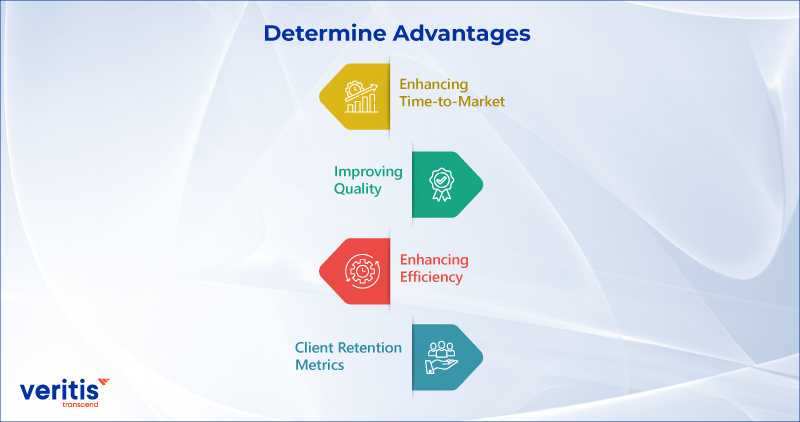
Upon the computation of the aggregate expenses entailed in adopting a DevOps methodology, the subsequent step thoroughly evaluates the advantages it confers upon your organization. Scrutinize speed-to-market enhancements, elevated quality standards, efficiency augmentations, and customer retention rates by incorporating DevOps practices.
1) Enhancing Time-to-Market
Quantify the enhancement in time-to-market efficiency by eliminating bottlenecks within development cycles through enhanced collaboration and streamlined, automated procedures, resulting in quicker product or feature deliveries.
2) Improving Quality
Measure the reduction in defects, glitches, and production incidents by quantifying the quality improvements brought about by implementing a DevOps culture that prioritizes continuous testing, monitoring, and feedback loops.
3) Enhancing Efficiency
Evaluate the rise in productivity and the optimization of resources resulting from refining workflows, automated deployment processes, and enhanced communication between development and operations teams.
4) Client Retention Metrics
Assess the influence of DevOps on customer satisfaction and loyalty through DevOps metrics analysis, including decreased churn rates and heightened levels of customer engagement.
Useful link: Veritis Bags the CIO Review Award for Its Exceptional DevOps Solutions
Deriving ROI from DevOps
A 2023 leading global survey features DevOps among the top impacting technology trends globally compared to other trending solutions.
Here are some current statistics on the adoption and impact of DevOps:
- 99% of organizations report that DevOps has positively impacted their business.
- 61% say DevOps has helped them produce higher-quality deliverables.
- 49% of DevOps report a reduction in time-to-market software and services.
- The global DevOps market is estimated to grow USD 12.2 billion by 2026.
What made DevOps so special? The answer lies in its impact on organizational performance.
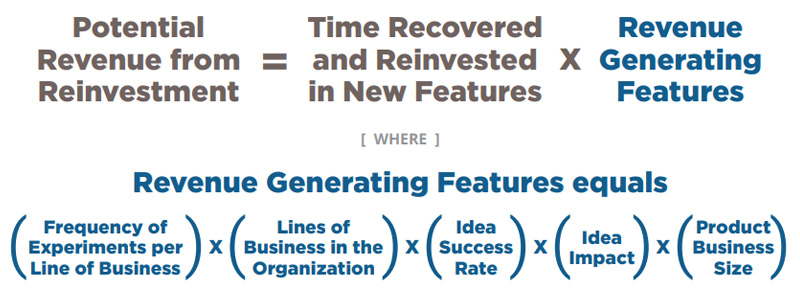
Here are Some More Current Statistics for DevOps:
Market growth
The global DevOps market is estimated to grow USD 24.71 billion by 2027, growing at a CAGR of 22.9% from 2023. (Source: Research and Markets)
The DevOps market is driven by the increasing adoption of cloud computing, continuous integration, continuous delivery (CI/CD), and containerization technologies.
Adoption
- 99% of IT professionals implementing DevOps say it has positively impacted their organization. (Source: Puppet)
- 61% of organizations say DevOps has helped them produce higher-quality deliverables. (Source: Puppet)
- 49% of organizations say that DevOps reports a reduction in time-to-market for software and services. (Source: Puppet)
Benefits
- DevOps organizations deploy software 200 times more frequently and recover from incidents 24 times faster than organizations that don’t use DevOps. (Source: DORA)
- DevOps organizations achieve 50% higher customer satisfaction rates than organizations that don’t use DevOps. (Source: DORA)
- DevOps organizations have 23% higher profitability than organizations that don’t use DevOps. (Source: DORA)
Trends
Some of the top DevOps trends for 2023 include:
- GitOps
- Observability
- Security as code
- Infrastructure as code (IaC)
- Kubernetes
- Multi-cloud and hybrid-cloud
Skills
The most in-demand DevOps skills in 2023 include:
- Cloud computing (AWS, Azure, GCP)
- Containerization (Docker, Kubernetes)
- CI/CD
- Infrastructure as code (IaC)
- Automation
- Programming languages (Python, Go, JavaScript)
These statistics demonstrate the continued growth and popularity of DevOps. Adopting DevOps practices should be a compelling consideration for organizations seeking enhancements in their software development and delivery processes.
Useful link: DevOps outsourcing: Things to Know About Before Getting Started
What to Measure for DevOps ROI?
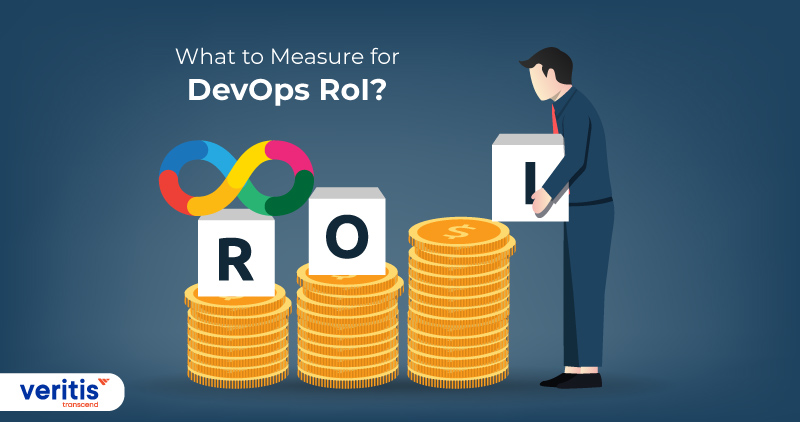
Return on Investment (ROI) is the first and foremost thing that organizations expect when undertaking a new technology transformation.
Organizations focused on ROI should have their cost calculations beyond technology acquisition, which can later include training, lost productivity, maintenance, rearchitecting, and replacement of existing systems.
So, ROI is merely measured in two ways: value-driven and cost-driven. Organizations often prefer improving processes for additional capacities rather than looking for recruit and hire.
Measuring a successful DevOps ROI requires consideration of three different DevOps metrics: Performance, Philosophy, and Velocity.
1) DevOps ROI by ‘Performance’ involves measuring:
- High IT Performers – Who see returns and superior software delivery
- Medium IT Performers – Get benefited by eliminating technical debts and prioritizing speed and value
- Low IT Performers – Who focus on improvement areas and opportunities to set measurable goals
2) DevOps ROI by ‘Philosophy’ involves measuring:
- People-oriented – Focus on productivity and work quality
- Process-oriented – Improving by feedback, implementation, and deploying upgrades
- Technology-oriented – Hardware, software and service functions
3) DevOps ROI by ‘Velocity’ Involves Measuring:
- Release Frequency – Speed of code releases to production
- Infrastructure Recovery – Rate of production recovery from failures
- Infrastructure Resiliency – Decline in downtime issues caused by infrastructure failures
- Infrastructure Efficiency – Resource shielding to protect from production deployment failures
- Automation – Reduced manual intervention to fix issues
- Iterations – Volume of changes made upon user requests/feedback
Knowing the factors and measures that drive ROI might not make this complete, as DevOps benefits for business outcomes are measured in monetary terms.
Calculating ROI from DevOps
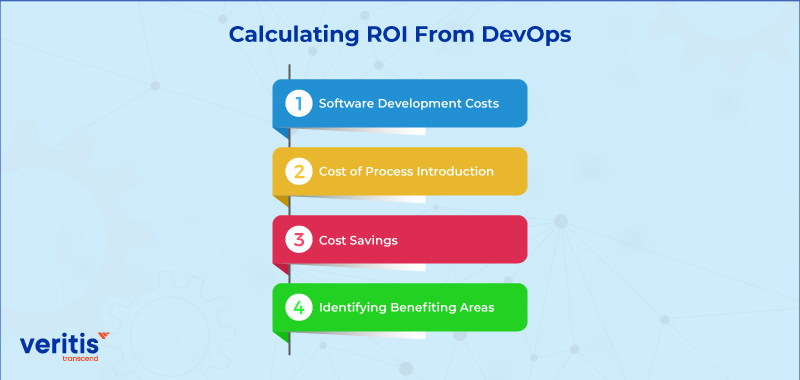
Calculating ROI from a DevOps strategy requires undergoing a four-step methodology:
1) Software Development Costs
Understanding cost savings begins with analyzing the existing costs. This should ideally begin with the hourly costs of software development. This is usually done by multiplying the average annual salary of a software developer with an account for benefits and employer costs and dividing the resultant figure by the number of working hours annually.
2) Cost of Process Introduction
Next comes the costs of introducing processes, from development environments and processes to CI and CD and data protection and preservation. All these processes involve a common thread despite changes in respective working practices. This is where automation plays a crucial.
High performers in DevOps report the lowest manual work across DevOps practices, meaning ‘increased automation’.
Besides the newly-introduced process, the costs caused by adjusting to a new working environment should also be mentioned (if any) to realize the actual investment. This means the costs required to catch up to new speeds through new tooling should be added to the overall tooling cost.
3) Cost Savings
Then comes the cost savings achieved through successfully implementing a particular DevOps implementation area. This has to be precise and accurate to quickly identify the overall financial advantage realized through that respective process.
4) Identifying Benefiting Areas
This is where the attributable value is calculated, comparing the cost savings and the costs incurred for introducing a process. This should be calculated over a year for short-term realization of savings and three years and further for long-term realization.
Compute Return on Investment (ROI)
To ascertain your DevOps ROI, divide the net benefits realized from implementing DevOps practices by the total costs expended. Multiply the outcome by 100 to represent it as a percentage.
ROI Calculation Equation:
ROI = (Net Benefits / Total Expenditures) * 100
Using this formula, you can gauge whether your DevOps investment generates favorable returns for your company.
Useful link: DevOps Implementation: 4 Steps to Success
DevOps Implementation Roadmap
Wait no more! See where you stand in your DevOps journey to get the best ROI from your DevOps investment and drive 100% percent customer satisfaction.
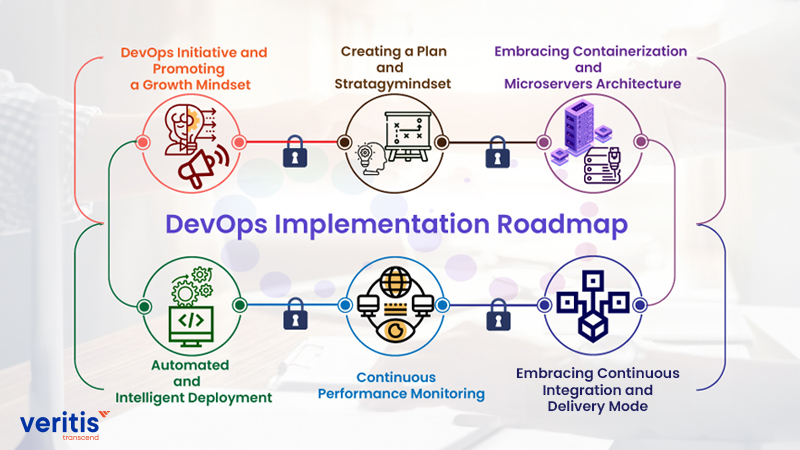
Conclusion
DevOps has profoundly transformed software delivery, enhancing team collaboration and efficiency. This shift has led to many advantages, including improved performance, increased productivity, faster time-to-market, cost savings, reduced failure rates, and quicker recovery. As a result, the demand for DevOps is soaring, with organizations recognizing its potential for significant Return on Investment (ROI).
Understanding the ROI of DevOps is vital for businesses seeking to quantify the financial impact of embracing this culture. Conducting a systematic ROI analysis offers crucial insights into the effectiveness of DevOps methodologies, empowering organizations to make the proper decisions regarding resource allocation and process improvements. Veritis, a distinguished industry leader and recipient of the Stevie and Globee Business Awards, offers DevOps services to help organizations harness the full potential of this transformative culture, ensuring optimal ROI and driving 100% customer satisfaction.
Looking for Support? Schedule A Call
Also Read:
- Measuring DevOps: Key ‘Metrics’ and ‘KPIs’ That Drive Success!
- Demystifying MLOps vs DevOps: Understanding the Key Differences
- AIOPS Solutions: Enhancing DevOps with Intelligent Automation for Optimized IT Operations
- Future of DevOps: Top DevOps Trends in 2023 and Beyond
- Explained: Pros and Cons of DevOps Methodology and its Principles
- How to Implement Artificial Intelligence in DevOps Transformation?